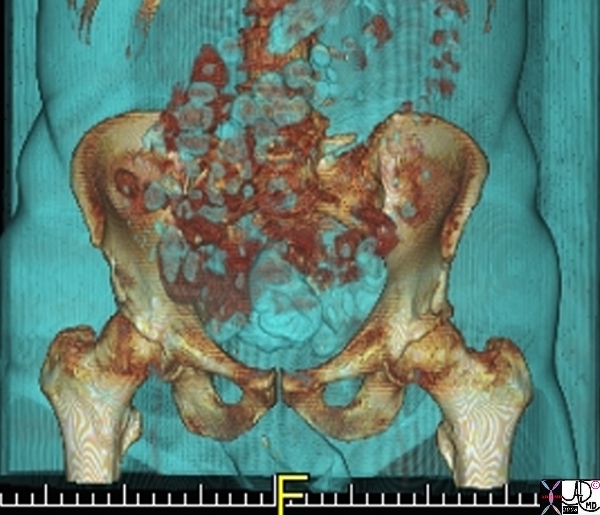The Common Vein Copyright 2011
Definition
Fractures of the the acetabulum are usually caused by high energy motor vehicle trauma or falls from a height are associated with acetabulum fractures which may affect the ilium, ischium, and or pubis. There can be an associated hip dislocation with the fracture.
Stable injuries do not deform with normal physiologic forces. Unstable injuries have either a rotational or vertical displacement.
The fracture pattern depends on the femoral head position, force, and age of the patient during the time of the injury.
The Judet-Letournel Classification of Acetabular Fractures is the most commonly used. There are 10 types of acetabular fractures according to the Letournel-Judet classification system.
The simple fracture patterns are through the anterior wall, anterior column, posterior wall, posterior column or transverse through the acetabulum.
Anterior wall fractures involve an injury to the anterior roof and acetabulum. The anterior column is mostly undisturbed.
Anterior column fractures involve a disruption of the iliopectineal line. There can be an anteromedial displacement of the femoral head.
Posterior wall fractures involve a disruption of the posterior articular surface, but an undisturbed posterior column.
Posterior column fractures involve disruption of the ischium. The fracture line starts at the greater sciatic notch and exits at the obturator foramen. There is a fracture of the ischiopubic ramus with possible medial displacement of the femoral head.
Transverse fractures cause the innominate bone to fracture into two fragments. There are three ways the fracture can occur. Transtectal is through the acetabular dome. Juxtatectal is through the fossa acetabuli and the acetabular dome. Infratectal is through the fossa acetabuli.
The complex fracture patterns include the anterior column with the posterior hemitransverse fracture, posterior column with the posterior wall, transverse type fracture with the posterior wall, T-shaped fracture, and a both column fracture.
The fracture may be complicated in the acute phase by neurovascular injury, or in the subacute or chronic phases by nonunion, malunion, infection, osteonecrosis, or osteoarthritis.
The diagnosis of this injury is usually made by a combination of physical examination and x-ray imaging.
Imaging includes the use of plain x-rays, and if indicated CT-scan, or MRI.
Treatment depends on the specific type of fracture and how acutely sick the patient is. Nonoperative treatment is reserved from fractures with minimal displacement. Patients may be initially non-weightbearing or partial weightbearing with the use of crutches to protect the healing fracture. For unstable fractures and those with other associated injuries the operative measures can be by an open reduction internal rotation (ORIF) procedure. The goal of treatment is to restore anatomic alignment of the articular surface.
Patients may be initially placed in skeletal traction to allow for soft tissue healing and maintain limb length.
ORIF procedures depend upon what part of the acetabulum is fractured. Surgery is usually done within 2 weeks of the initial injury. Plates, screws, and pins are used to obtain an anatomic reduction.
Complications of acetabular fracture surgery include infection, heterotopic ossification, avascular necrosis, chondrolysis, thromboembolism, and nerve injury.

Courtesy Ashley Davidoff MD copyright 2008 71198b
Davis MF, Davis PF, Ross DS. Expert Guide to Sports Medicine. ACP Series, 2005.
Elstrom J, Virkus W, Pankovich (eds), Handbook of Fractures (3rd edition), McGraw Hill, New York, NY, 2006.
Koval K, Zuckerman J (eds), Handbook of Fractures (3rd edition), Lippincott Williams & Wilkins, Philadelphia, PA, 2006.
Lieberman J (ed), AAOS Comprehensive Orthopaedic Review, American Academy of Orthopaedic Surgeons, 2008.
Moore K, Dalley A (eds), Clinically Oriented Anatomy (5th edition), Lippincott Williams & Wilkins, Philadelphia, PA, 2006.
